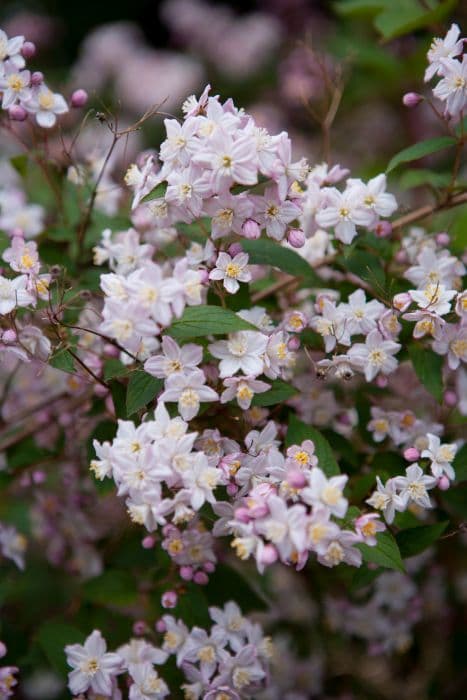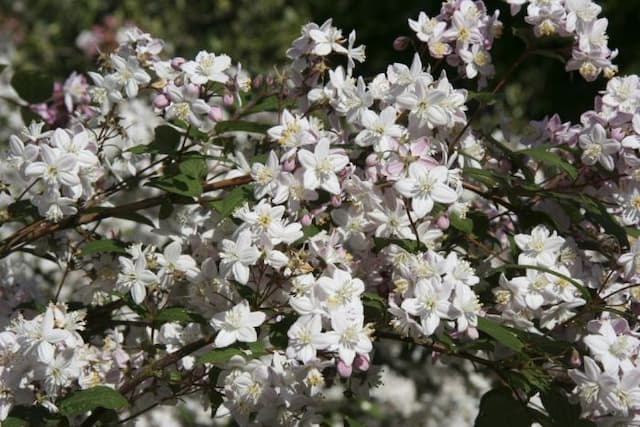Mock Orange Philadelphus 'Dame Blanche' (d)

ABOUT
The Philadelphus 'Dame Blanche', commonly known as the Mock Orange 'Dame Blanche', is a deciduous shrub that is cherished for its decorative appeal. It dons an elegant array of dark green leaves that create a lush backdrop for its stunning floral display. The leaves have a simple shape with slightly serrated edges, emanating a fresh, green look throughout the growing season. The true spectacle of the Mock Orange 'Dame Blanche' comes with its flowers. It produces an abundance of small, cup-shaped blooms that are pure white in color. These delicate flowers are richly fragrant, emitting a scent reminiscent of orange blossoms, which is especially potent in the late spring to early summer during the height of its blooming period. Each flower consists of multiple petals that are sometimes slightly ruffled, adding to their visual charm. The plant's branches are quite graceful, forming a mounded shape that adds to its ornamental value. The overall form of the 'Dame Blanche' is quite neat and compact, making it a favored choice for gardeners looking to fill their gardens with lush foliage and vibrant displays of white blooms that can add a touch of elegance and sweet perfume to any setting.
About this plant
 Names
NamesFamily
Hydrangeaceae
Synonyms
Mock Orange, Sweet Mock Orange, English Dogwood
Common names
Philadelphus 'Dame Blanche'
 Toxicity
ToxicityTo humans
The plant commonly known as Mock Orange, including the variety Philadelphus 'Dame Blanche', is generally considered non-poisonous to humans. There are no well-documented cases of toxicity from ingesting parts of this plant. Therefore, there are no specific symptoms of poisoning associated with Mock Orange, as it is not known to be toxic.
To pets
Mock Orange, including the variety Philadelphus 'Dame Blanche', is also generally considered non-toxic to pets. It is not known to cause serious illness or symptoms of poisoning in animals if they ingest parts of the plant. Therefore, pet owners do not typically need to worry about toxicity from this plant.
 Characteristics
CharacteristicsLife cycle
Perennials
Foliage type
Deciduous
Color of leaves
Green
Flower color
White
Height
4 feet (1.22 meters)
Spread
4 feet (1.22 meters)
Plant type
Shrub
Hardiness zones
5
Native area
Southeastern Europe
Benefits
 General Benefits
General Benefits- Easy to grow - Philadelphus 'Dame Blanche' is a hardy shrub that is simple to cultivate in a variety of garden conditions.
- Attractive flowers - It produces white, fragrant blooms that are aesthetically pleasing and can enhance any garden space.
- Wildlife-friendly - The flowers attract pollinators such as bees and butterflies, supporting local ecosystems.
- Low Maintenance - Once established, it requires minimal care, making it a great choice for both novice and experienced gardeners.
- Hardiness - It is a robust plant that can withstand cold temperatures, making it suitable for many climates.
- Seasonal Interest - Offers visual interest in spring and early summer with its profusion of blooms.
- Versatile Planting - Can be used in mixed borders, as a stand-alone specimen, or for informal hedging.
- Scented Garden Addition - The fragrant flowers can create a pleasantly scented environment in the garden.
- Deciduous Nature - Its deciduous nature means it won't block winter sunlight when planted near a home.
- Pruning Tolerant - Tolerates hard pruning, which can rejuvenate older plants and keep them looking their best.
 Medical Properties
Medical PropertiesThis plant is not used for medical purposes.
 Air-purifying Qualities
Air-purifying QualitiesThis plant is not specifically known for air purifying qualities.
 Other Uses
Other Uses- Philadelphus, commonly known as Mock Orange, can be used to create natural outdoor spaces for meditation or quiet reflection, as its dense foliage provides privacy and its fragrance adds to the calming environment.
- The wood of Mock Orange is suitable for making small handcrafted objects like tool handles or carved ornaments due to its solid and workable nature.
- Mock Orange can be trained to grow over arches or pergolas, offering a living, scented canopy in garden design.
- The fragrant blossoms of Mock Orange can be used in potpourri mixtures to impart a fresh, citrus-like scent to your home.
- The versatility in size and shape makes Mock Orange hedges a natural choice for topiary projects in gardens.
- Dried branches of Mock Orange can be used for kindling or starting fires in outdoor fire pits because they burn well when dry.
- The dense growth of Mock Orange makes it a good candidate for noise reduction in the garden, as it can help to muffle traffic sounds or noisy neighbors.
- In photography and film, Mock Orange can be used as a vivid and attractive backdrop for outdoor shoots, providing a lush and romantic setting.
- Mock Orange can act as a natural trellis for climbing plants, offering support for vines to intertwine with its branches.
- When planted strategically, Mock Orange can be used as a windbreak to protect more delicate plants from strong winds or to create microclimates within a garden.
Interesting Facts
 Feng Shui
Feng ShuiThe Mock Orange is not used in Feng Shui practice.
 Zodiac Sign Compitability
Zodiac Sign CompitabilityThe Mock Orange is not used in astrology practice.
 Plant Symbolism
Plant Symbolism- Innocence: The Philadelphus, also known as Mock Orange, often symbolizes purity and innocence due to its white flowers reminiscent of orange blossoms.
- Purity: Similar to innocence, the white color of Mock Orange blossoms traditionally represents cleanliness and virtue.
- Fraternal Love: The genus name, Philadelphus, originates from Greek words 'philos' meaning loving and 'adelphos' meaning brother, tying the plant to feelings of brotherly love and devotion.
- Renewal: As the Mock Orange blooms in spring, it is frequently associated with rebirth and the refreshing quality of the season.
- Memory: The intense and sweet fragrance of the Mock Orange is said to linger in the senses, much like cherished memories.
 Water
WaterFor the Mock Orange, it's important to maintain moist but not waterlogged soil, especially during its blooming period and the first few years after planting to establish the root system. In general, water the plant deeply once a week with about 1-2 gallons per watering session, depending on the local climate and soil drainage. During hot, dry spells, you may need to water more frequently to prevent the soil from drying out completely. Reduce watering in the winter when the plant is dormant, ensuring the soil doesn't become completely dry.
 Light
LightThe Mock Orange thrives in a location that receives full sun to partial shade. The ideal spot would allow it access to at least four to six hours of direct sunlight daily. If you're planting it in a particularly hot climate, giving it some afternoon shade will help protect it from the most intense sun.
 Temperature
TemperatureMock Orange plants are quite hardy and can withstand a range of temperatures but perform best when grown in the USDA hardiness zones 4 through 8. They can survive minimum temperatures down to about -30°F and are comfortable up to 90°F. The ideal temperature range for optimal growth is between 60°F and 75°F.
 Pruning
PruningPrune the Mock Orange immediately after it finishes blooming, usually in late spring or early summer, to maintain its shape and size and to encourage the growth of new wood, which will bear flowers the following year. Remove any old or dead wood, and thin out crowded branches to improve air circulation. Since the plant blooms on the prior year's growth, timely pruning is important to not remove the next year's blooms.
 Cleaning
CleaningAs needed
 Soil
SoilMock Orange 'Dame Blanche' prefers well-drained, fertile soil with a pH range of 6.0 to 7.5. A good soil mix for this plant would consist of garden loam, peat moss, and a small amount of compost to enrich fertility.
 Repotting
RepottingMock Orange 'Dame Blanche' is typically grown in the ground and does not require frequent repotting. If grown in a container, repotting every 2 to 3 years should suffice to refresh the soil and accommodate root growth.
 Humidity & Misting
Humidity & MistingMock Orange 'Dame Blanche' is adaptable to a wide range of humidity levels and does not require specific humidity conditions to thrive outdoors. It is overall humidity tolerant.
 Suitable locations
Suitable locationsIndoor
Ensure bright indirect light and good air circulation for indoor Mock Orange.
Outdoor
Plant in well-drained soil, full sun to partial shade for outdoor Mock Orange.
Hardiness zone
4-8 USDA
 Life cycle
Life cycleThe Mock Orange 'Dame Blanche' begins its life cycle when a seed germinates in spring, usually after a period of cold stratification which breaks seed dormancy. It then develops into a seedling, establishing a root system and sprouting its first leaves. As it matures into a young plant, the Mock Orange 'Dame Blanche' develops a woody stem and foliage, entering the vegetative growth phase where it focuses on gaining size and strength. After a few years, the plant reaches maturity and starts the reproductive phase, characterized by the production of fragrant, white flowers in late spring or early summer, which are pollinated by insects. Following pollination, it produces small fruit that contains seeds, completing the reproductive cycle. Over time, the plant may undergo periods of dormancy during colder months, shedding leaves if deciduous, and then resuming growth as the climate warms.
 Propogation
PropogationPropogation time
Late winter to early spring
Propogation: The Philadelphus 'Dame Blanche', commonly known as Mock Orange, is typically propagated during late winter or early spring before new growth begins. The most popular method is softwood cuttings, which involves taking a 4 to 6-inch-long (10 to 15 cm) cutting from a healthy, non-flowering stem. The lower leaves are removed, and the cut end can be dipped in rooting hormone to encourage root development. The cutting is then planted in a pot with well-drained soil, ensuring at least two sets of leaves are above the soil surface. The pot should be placed in a warm, bright area but not in direct sunlight, and the soil should be kept moist but not waterlogged. Roots generally develop within a few weeks, after which the new plant can be gradually acclimatized to outdoor conditions before transplanting into the garden.






![Hydrangea [Early Sensation]](/_next/image?url=https%3A%2F%2Fplants-admin.emdemapps.com%2Fimages%2Fplants%2F%2Fimages%2F604b6150338db.png&w=640&q=75)


